| |
|
| |
|
This little
building is situated just to the north of
Southwold and Reydon's urban sprawl. Actually,
that makes it sound rather suburban, and it isn't
at all, for the tiny lanes that spread between
here and the curiously named Frostenden Bottom
are as narrow, overshadowed and remote as any
you'll find anywhere up here in the north east of
the county. The village here is called South Cove
to distinguish it from Covehithe, formerly simply
Cove, rather than from North Cove which is away
on the Norfolk border. There isn't really much of
a village here at all, and when I first visited
in 1998 there was only one service a month. But
this is as pretty and as well-cared for a church
as you could wish, and despite its location on
the busy Southwold to Wrentham road it has a
lovely setting beside a farmyard, and like all
thatched churches looks very fine. If you've ever
seen the film Iris, the story of the
writer Iris Murdoch, you may recognise it as the
church where she gets married.
You step from the trim churchyard through the
fine Norman south door into a thoroughly
Victorian interior, reminiscent of Uggeshall and
Sotherton. It has aged well; someone with
imagination worked here. The interior is narrow,
with a fine medieval roof, and the Victorianisms
shouldn't distract us from the fact that this is
essentially a Norman building, with much
surviving evidence.
Isn't it strange how you can never really
disguise a Norman church? You can punch its walls
with Dec and Perp windows, you can add an
elaborate tower at the west end, you can fill it
full of pitch-pine pews, but it still retains
that essential Norman-ness. There's a typical
East Anglian font, in pretty poor condition. The
central gangway widens towards the west, which is
rather pleasing. The modern reredos includes a
gridiron, the instrument of St Lawrence's
gruesome torture. Part of the medieval roodscreen
survives, with apparently medieval painting at
the top, but no images on the panels of the dado.
The great treasure of the church has been
well-preserved. It is a large piece of wood, two
planks in fact, set in the entrance to the rood
loft stairs, and on it is painted the archangel
St Michael triumphing over a dragon. It may well
have been that rood loft stairways originally had
doors - indeed, hinges survive at some churches.
But there is no getting away from the fact that
this does not look like a door. There is no
handle, and no hinges, for a start. So, what is
it?
I think we would be correct to assume that the
16th century reformers were keen to get rid of
rood loft stairs, either out of theological
expediency, or simple embarrassment that they
could ever have fallen for those papist tricks.
As anyone who has dabbled in DIY will tell you,
the easiest way to block up an entrance is to
close the door and plaster over it (I ought to
add that I've never dabbled in DIY - I asked
someone.)
If there isn't a door, then you fit panels into
the space, and then plaster over it. I'm guessing
here, but I think that when the Victorians went
about their business resacramentalising the
churches of England and Wales, they deliberately
opened up rood loft stairs to restore a sense of
the medieval. Some stairway entrances had been
filled with rubble. But mostly, they'd been
covered over, and plastered. You'd find them by
the hollow sound when you tapped them. The
Victorians stripped back the plaster, removed the
panelling, burnt it, and thought no more about
it.
Except here. The Victorians seem to have
discovered something rather remarkable and
exciting (it simply isn't credible that this
image survived the long puritan nightmare of the
Church of England on display). I think this image
spent several centuries under plaster - note the
damage done by a sharp instrument. At first
sight, you might think that this is an example of
protestant iconoclasm. But it isn't. A
professional plasterer friend of mine tells me
that this is what you have to do to wood to get
the plaster to stick to it.
So, we must ask ourselves: what was this
panelling originally? Was it a door? Or was it
put there in the 1540s to block the rood loft
off? And if so, where was it taken from? Was it
originally from a doom tympanum, as at Wenhaston?
I couldn't help being reminded of the wonderful
archangels on the rood screen at Ranworth in
Norfolk. Could it have come from one of the
Dunwich churches before it was lost to the sea? I
suppose we'll never know. |
|
|
Simon Knott, November 2018
 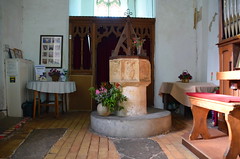 
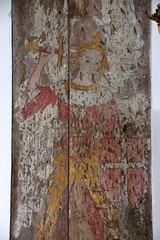 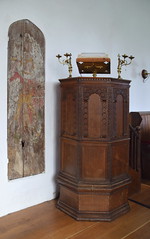 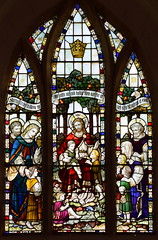  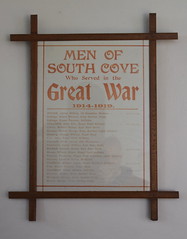
| |
|
| |
|
|
|
|
|
|
|
| |
|
|
|
|
|
|
|
|
The Churches of East
Anglia websites are
non-profit-making, in fact they
are run at a considerable loss.
But if you enjoy using them and
find them useful, a small
contribution towards the cost of
web space, train fares and the
like would be most gratefully
received. You can donate via
Paypal.
|
|
|
|
|
|
|
|
|
|
|
|
|
|
|
|
|
|
|
|
|
|
|
|
| |
|
|
|
|
|
|
|
|
|
|
|
|
|
|
|
|
|
|

